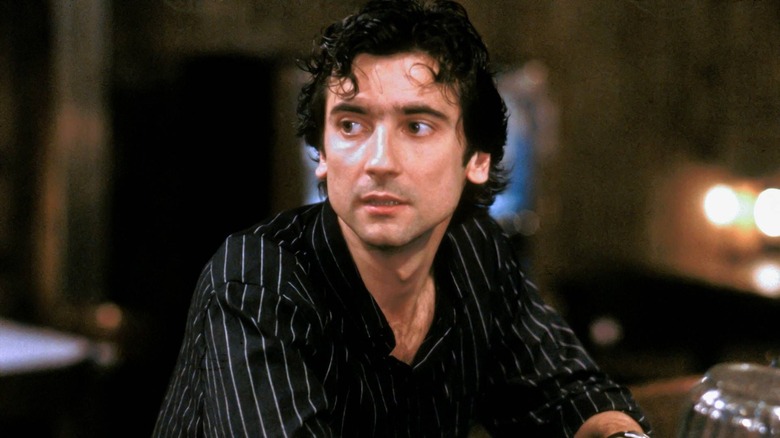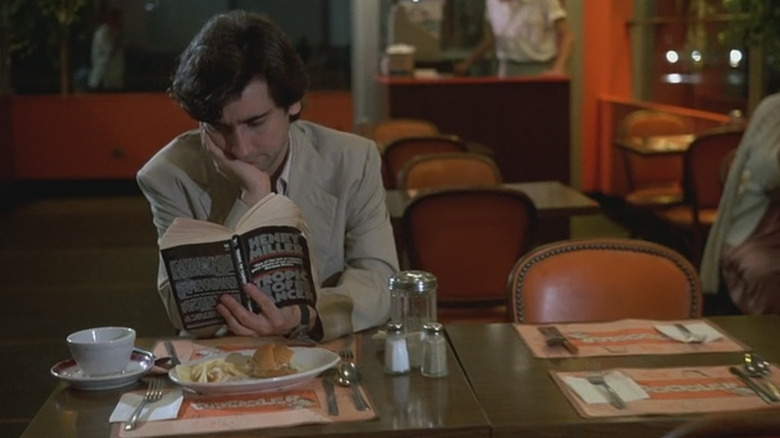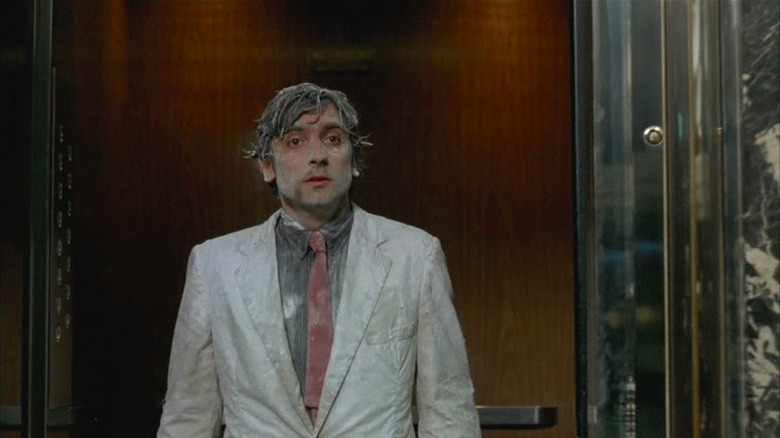One Of Martin Scorsese's Most Underrated Movies Almost Ended In This Totally Bonkers Way
Martin Scorsese's surreal 1985 black comedy "After Hours" is equal parts hilarious and panic-inducing. The film follows a shallow yuppie named Paul Hackett (Griffin Dunne) who spends his days plugged into an ultra-modern computer, a novelty in the mid-'80s. After work, Paul goes to a diner and has a chance encounter with a woman named Marcy (Rosanna Arquette), a free-spirited artist who invites him back to her place, ostensibly to buy some art, but more presumably for a night of casual sex. Paul's night starts out badly — his only $20 bill blows out the window of his taxi — and only gets worse. Marcy and her sexed-up roommate Kiki (Linda Fiorentino) begin to exhibit some very strange behavior, leading Paul to flee into the street. He is broke in New York at 1:00 a.m. with no means of getting home. It starts to rain.
Over the course of the movie, Paul will be accused of terrible crimes, a posse will be hunting him, and some people might die.
Eventually, to flee his pursuers, Paul will be encased in papier-mâché by another artist named June (Verna Bloom). As a statue, Paul is stolen and transported around town. The film ends with Paul returning to work the next morning. Some might say that, when the gates to his office building open and Paul is revealed to be covered in white plaster dust, that he is passing into the afterlife. Whether it is Heaven or Hell can be debated. Either way, the whole night was hellish. It's easy to see that Scorsese was constructing his version of a supernatural afterlife story. After hours indeed.
In the 2004 making-of documentary on "After Hours" included on the film's DVD release, actor Dunne explains that the film originally had an even more surreal ending.
Hiding in the womb
It seems several possible endings were floated as possibilities. The film's editor, Thelma Schoonmaker, recalled an ending where Paul flew away in a hot air balloon. The ending Griffin Dunne most vividly remembers — and it was an ending that even had a storyboard — involved him climbing into the womb of another character. As Dunne described it:
"The ending that we didn't go with — though it is the most unforgettable — is Verna Bloom says, 'I have a place where you can hide, I know where you can hide.' And she looks down, and I realize she means for me to climb inside her, into her womb. And then we're on the West Side Highway, and she gives birth to me. And I'm, like, born out of her on the West Side Highway, and I'm covered in goop."
If one is to accept that "After Hours" is about a man experiencing the afterlife or purgatory, then being literally reborn would be a wonderful spiritual button to the proceedings. He would die, experience wrathful blood-drinking deities, and be reincarnated. That ending, then, would stage "After Hours" as a specifically Buddhist parable. By certain Buddhist tenets, if a person cannot accept that they are dead, then their afterlife becomes dark and demonic. If they can accept it, then their experience becomes heavenly. Then they can be reborn into another body.
Martin Scorsese didn't go for that ending, however. Schoonmaker points out that famed director Michael Powell ("The Life and Death of Colonel Blimp," "Peeping Tom," and dozens of others) had seen early cuts of the movie, and it was he who suggested that Paul merely return to work the next day.
No, not that. Yes that.
Martin Scorsese initially hated Powell's idea. But after weeks of brainstorming an ending and not coming up with anything that was wholly satisfactory, he finally came around to it. He shot the end the way it was seen.
Griffin Dunne said that the ending was great and that it captured the way of life — one might have a rough, almost apocalyptic night, but one has to stand up, brush off, and merely go to work the next day.
It's worth noting that symbols of being reborn, as well as symbols of brushing off and getting back to work, were significant for Scorsese in 1985. His previous film, 1983's "The King of Comedy" bombed terribly at the box office, and the filmmaker was having no small amount of trouble developing his next film, "The Last Temptation of Christ." Scorsese had never experienced that level of professional failure all at once before, and he probably wasn't feeling very good about himself. Rather than keep on pursuing "Temptation," he decided to make a smaller, more modest movie with "After Hours." It was well-received, and many admire it to this day. With "After Hours," Scorsese was reborn. Or he was just brushing himself off after a stumble.
It seems both endings would have functioned perfectly well. Scorsese eventually made "Temptation" in 1988. It was a controversial hit and earned Scorsese a Best Director Oscar nomination. His next two films were "GoodFellas" and "Cape Fear." It seems he quickly got back on top.


